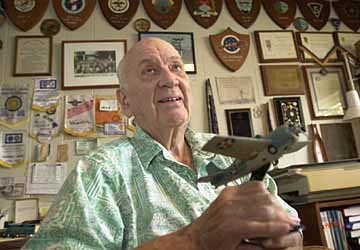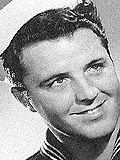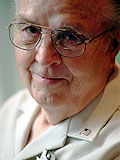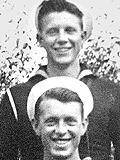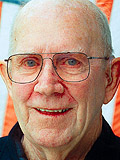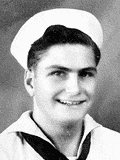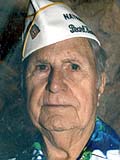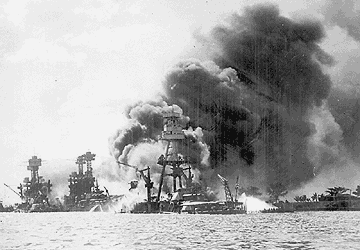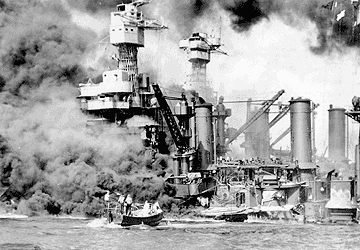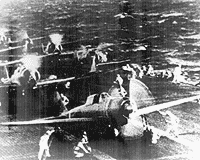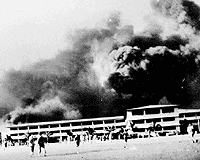 |

|

From the shore of Pearl Harbor, Joe Morgan can see the past as clearly as he can see the present. He goes there on Thursday mornings, to the visitor center of the USS Arizona Memorial, and shares the story of the day his life changed. Dec. 7, 1941. America changed that day; the world, too. But people like Morgan, ordinary people - sailors, soldiers, citizens - also would never be the same. They saw massive destruction, choked on the smoke of burning battleships and burning flesh, saw death up close. Morgan has told his story, a simple one, for 15 years. The Honolulu resident is convinced that sharing his memories keeps him alive. He has had a heart attack and undergone three open-heart surgeries. Sometimes, age clouds his memory, but Morgan's will remains strong. On days when he plans to visit the memorial, he's up early, surging with adrenaline. Morgan is 79, a retired Baptist minister, a Pearl Harbor survivor. On that distant morning, he was a 19-year-old aviation ordnance man third-class. He lived and worked on Ford Island. Behind glasses, Morgan's eyes light up at the memory of that lean, young man with thick, dark hair. "It was like being on vacation," Morgan said. He was a long way from home, Little River, Texas, a long way from the failing grades that convinced him to drop out of high school, a long way from the church and the calling he had hoped to answer. Morgan came from a church-going clan. His father and grandfather were lay preachers. As he was growing up, Morgan was convinced he, too, would become a preacher. At 17, he gave his first sermon during one of the evening services his church used to see if a person had "the gift." But he joined the Navy to see the world and wound up in Hawai'i, where he got liberty every four days. Soon, Morgan wasn't going to church. In his home town, they would have called him a backslidin' Baptist. When the bombs began to fall, Morgan's first reaction was to run for cover. | See Battle, Page 7 He was terrified, "shaking in my No. 8 shoes," so he wedged himself into the recess of a large steel I beam. Then he realized his buddies were shooting back at the Japanese attackers with aging, single-shot rifles. He ran to a PBY Catalina bomber, firing a machine gun mounted inside. He stayed there all day and all night. And in that fuselage of that plane, bullet holes all around him, Morgan had an epiphany. "I didn't think the Lord sent the attack to Pearl Harbor just to wake me up, but he used it to create the realization I was out of his will," Morgan said. "I got down on my knees and promised that if I lived through the war I would join the ministry." And he did. He was transferred to Maui and never saw another day of combat. After he got out of the Navy in 1946, Morgan went on to get his high school equivalency diploma, attend college and a Baptist theological seminary. Right away, he was sent back to Maui, where he became the pastor of the Wailuku Baptist Church. But in 1972, Morgan was back in the Navy as an active-duty reservist, chaplain to ships during the Vietnam War. In all, he spent 40 years as a minister. He used to go to Tripler Army Medical Center and visit veterans. He married couples and presided over funerals, some of them at the Arizona Memorial. The attack on Pearl Harbor brought one other significant change to Morgan's life. It led to a marriage of nearly 60 years. Before the attack, he had dated a woman, Blanche Fernandes, for a few weeks. They met at a dance. Practically all they did that night was talk. But she ended the relationship. Until that Sunday morning, when she feared she had lost Morgan forever. It was two weeks before she heard he was OK. "There was something about her that gave me a joy for living," Morgan said. They were married on March 7, 1942. Blanche is always a part of Morgan's story. It makes the listeners smile before they cry. She used to go with him to the memorial, ride the bus home with him. Her photo is in the brochure he gives out. In the summer of 2000, she got sick. At first, Morgan stayed home with her. But not telling his story made him restless. His son Robert noticed that and decided to take his father for his Thursday talks. They learned to work as a team, the son gently interviewing the father. Robert said this is his father's sermon, his only ministry. This summer, the family videotaped an interview with Joe and Blanche Morgan. Their story about a day that changed their lives. A few days later, Blanche passed away.
By the time he retired as a Navy captain, James Daniels had flown 120 combat missions in three wars. More than once, he saw good pilots shot down. That taught him how to forget. "A combat pilot doesn't think," Daniels said. "He tries to ignore it as much as he can." But at 86, that's become more difficult. On his mind these days: Five young pilots - all of them good friends - whose planes were shot down above Pearl Harbor on the night of Dec. 7, 1941, by panicked U.S. sailors. Three of them died in the hail of "friendly fire." Daniels was also in the air that night, the sixth pilot and the only one to safely land his plane on Ford Island. Now he is the only one left to tell the tale. "You think about it a lot," Daniels said. "You are the only guy left alive. It scares the hell out of you." When Pearl Harbor was attacked he was with the aircraft carrier USS Enterprise, searching for the Japanese fleet. "I don't know," he said. "It affects me. I've never had anything affect me as strongly as that. But I don't live with it day in and day out." Still, at Dec. 7 anniversary ceremonies, he travels to the Arizona Memorial and speaks about the friends who perished that Sunday. Lt. (jg) Fritz Hebel. Ensign Herb Menges. Ensign Eric "Ethan" Allen, the tenor from the Naval Academy who took a 50-caliber shot to the chest as he hung from a parachute. "They were killed by their own people," he said. "But nobody realizes that these guys were killed for their country." At one reunion, he shook hands with one of the sailors who filled the sky with lead that night, a retired Baptist minister who apologized for firing at Daniels. Daniels, a Kailua resident, spent 35 years in the Navy. He received medals for combat missions and commanded the aircraft carrier USS Ticonderoga. He learned to fly, to fight and to forget. But he doesn't want to forget his friends. It's the reason he tells his story. Their story. "To me, it's very powerful that they gave their lives," Daniels said. "I carry their memory for them."
The torpedoes came with pounding fury, one after the other, until seven of them had ripped open the battleship USS Oklahoma. With water rushing in, the ship began to capsize until its mast and superstructure jammed into the harbor bottom mud. It took 11 minutes. One-third of the approximately 1,350 crewmen were still inside. Only 32 made it out alive. The attack did something to Oklahoma sailors Richard Artley and Richard Husted. It was like someone tied a knot in their memories that they could not unravel. Artley, because he was trapped inside. Husted, because he wasn't. When the attack began, Artley was aft in the steering room with seven other men. They closed hatches against the flood as the ship turned over. Then the lights went out. Some Oklahoma survivors say the idea of drowning still haunts their thinning ranks. The 79-year-old Artley is a veteran of battles at Iwo Jima and Okinawa, but he dwells more on the 36 hours he spent in that dark compartment. "I don't think there has been a day since Dec. 7, 1941, that I haven't thought about it," Artley said. "It is something that comes and goes every day. I don't know why, but I can't get it out of my mind for some reason." It was a big room, 40 feet long, 30 feet wide and more than twice as tall as the average man. The sailors used a mattress and clothes to stop water from coming through a large blower pipe, but the water kept coming. "There wasn't much assurance we would ever get out," Artley said. "I didn't think we would." They used metal tools to bang on the hull until the rescue workers found them, communicating at times in the tap-tap-tap of Morse code. At the end, with rescue workers about to remove a hatch, the trapped men had 10 or 15 minutes left before the compartment filled completely. They were treading water. "There was absolutely no air in there," he said. The Oklahoma suffered 429 casualties, 381 of which were never identified. One of them was Artley's older brother, Daryle, who worked in another part of the ship. His body was never found. They were two young brothers from Woodland, Wash., who had joined the Navy because it offered jobs during the Great Depression. "We were very close," Artley said. "I think about him all the time." After the war, Artley went to work for the Port of Portland, Ore., retiring as a superintendent after 35 years. Artley, who lives in Lewiston, Idaho, with his wife, Norma, has never returned to Pearl Harbor or attended a Dec. 7 anniversary ceremony. Too many "damn politicians," he said. And unless he is at a reunion of Oklahoma survivors, he doesn't talk about that infamous Sunday. For 35 years, Husted shared a similar silence. Only his wife knew how he felt. He had spent the night before the attack with his aunt and uncle, who were in charge of an Army officers' beach in Hale'iwa. Uncle Ted, a sergeant, had duty that Sunday at Schofield Barracks, so Husted rode in with him. They saw the Japanese planes bearing down on nearby Wheeler Field as they arrived at the main gate. Husted doesn't remember how he got to Pearl Harbor, but the Oklahoma had already capsized by the time he did. "I had guilty feelings for not being aboard her, at my battle station," he said. "It was a heavy burden. She was my first ship." Husted spent 30 years in the Navy, retiring as a commander. His catharsis came five years after retirement, in 1975, when he joined a Seattle-area chapter of the Pearl Harbor Survivors Association. The following year, members convinced him to fly to Hawai'i for his first Dec. 7 anniversary. At his hotel, he bumped into a group of Oklahoma survivors sitting poolside. One of the survivors had been among those 32 sailors rescued from the capsized battleship. They got to talking about the attack, Husted said, and about how he felt all those years. "It turned me loose," Husted said. "There was nothing I could have done had I been there." Husted is 80 years old. He divides his time between San Antonio, Texas, and Honolulu. When he's here, he goes to the Arizona memorial twice a week to talk to visitors. "I can handle it now," he said.
When Ed Chappell was a police officer in Alhambra, Calif., he would often go to bed knowing the nightmares about Pearl Harbor would awaken him before dawn. A vicious crime was usually the trigger. Homicides would prompt them almost every time. Violence begat violent memories. "My wife said I would wake up at night and be screaming like hell, trying to get under the covers, trying to hide from her," Chappell said. "She knew what was happening to me." In the fall of 1941, Chappell was a 17-year-old Colorado farm boy who wound up as a mess cook aboard the battleship USS Maryland. The job usually found him scurrying between sailors and the chow line, bringing them food for tips. As the Japanese attacked, bombers came so close to the Maryland that Chappell can still remember the face of one pilot. Blazing machine guns turned the battleship's teak deck into shrapnel. He felt the concussion when the battleship USS Arizona exploded. But there were worse things for a teenage boy to experience, things that made him grow up "in a damn big hurry." "Anybody who says they were not scared that day or doesn't recall it is full of it," he said. That first night, sailors with rifles lined the deck of the Maryland, fearful that the Japanese would soon launch an invasion. "I was near the Oklahoma and I could hear those guys in there, tapping, 'Here we are, help us,'" Chappell said. "And there were guys in the burning water, screaming, and there was not a damn thing you could do about it." Chappell, who now lives in Lake Havasu City, Ariz., joined the Pearl Harbor Survivors Association in 1963 and serves as the group's national president. At 77, he is one of the younger members of a group that loses 50 people a month. In talks to community groups, he reminds them to never forget Pearl Harbor, but there are things he would like to forget. That won't happen, and he knows it. "When you have something like that happen to you, it is embedded in your mind forever," he said. "I could do without it."
"Arrived at Pearl Harbor December 1940 and was assigned to the USS Nokomis (YT142), which was located at Pearl Harbor Yardcraft. Our berthing space was located next to the marine runway about one-half mile across from Battleship Row. "On the morning of Dec.7, 1941, we left our berth and amid the bombing and strafing headed toward the burning ships offering assistance in tugboat duty, fire-fighting and picking up people from burning water. The harbor was ablaze from fuel released from USS Arizona. All the craft from Yardcraft responded, fighting fires and rescuing people in the water. "We assisted USS Nevada in getting under way from her berth north of Ford Island. We were alongside escorting her toward the channel when we suffered damage from dive bombers, and ran aground rather than block the channel to the sea. "Our next assignment was to tie up alongside the USS California and proceed to flood the lower decks with our fire hoses. She was on fire eternally. "That evening the harbor erupted with firepower when some of our own aircraft tried to land at Ford Island; big fires on the runways indicated that some of the planes didn't survive the landing. "During the attack I noticed a tanker out in the harbor. Found out later it was the USS Neosha moving away from the USS California. "We spent the next day alongside the USS California pumping water into lower decks until the fires were out. Pumping all that water was a factor in the ship bottoming out. – F.M. Burke, 81, Kapolei, lifetime member of the Pearl Harbor Survivors Association : : "'General quarters, general quarters, all hands man your battle stations,' interrupted the prayer meeting my buddy Vendrick and I were having on the third deck of the Battleship Tennessee, prior to attending divine services on the quarter deck. We thought it was a strange time for a drill until the second frantic call to general quarters was interrupted by the first bomb blast that hit our ship. The time was about 0800 hours. "Wide-eyed we ran for our battle stations. I remember saying to Vendrick, 'If I don't see you down here, I will up there.' There was another thud or blast as I headed for my damage-control battle station on the starboard side of the third deck. We were dogging down the hatches when they were opened from the other side so they could carry the first casualty through on a stretcher. Now things were getting more real. "Then they passed the word, 'Engineer of Number 2 Motor Launch, man your boat on the double!' That was me, so I headed up the ladder for topside where flames and smoke from the Arizona (right behind us) greeted me. I ran to the boom and rope ladder where 2 Motor Launch lay in flames of burning oil from the Arizona. It would have been suicide to carry out that order. "Choking in smoke, I ran back to my battle station via my locker, where I grabbed all my T-shirts to use as bandages, or possibly filters, to help our breathing. From there on, it was fighting fire and carrying ammunition until the second attack was over at about 10:00 a.m. We prayed that they would not come back for a third attack and take over the Island. "The Tennessee took two direct armor-piercing bomb hits, but remained the only battleship afloat apart from the Pennsylvania in drydock. The reason we didn't blow up like the Arizona, might be the fact that our catapult (located on top of Number 3 Turret) for launching reconnaissance sea planes, was turned at an oblique angle to facilitate room for the planned chapel services. The armor-piercing bomb hit the catapult and exploded, rather than possibly penetrating the magazine below, loaded with powder kegs for the turret … "This might be the reason I'm still around to celebrate the 60th anniversary after 50 years of missionary service.'" – Gordon Gustafson, 80, Bradenton, Fla., retired missionary, Cadence International : : "I was aboard the USS Utah (XBB31) on December 7, 1941, and on that morning I was in the liberty section, planning to go ashore to celebrate my promotion to carpenter's mate second class. Between 0700 and 0730 I went to the tailor shop to pick up my neckerchief and one for Reed SF3. While there (just below the quarterdeck), I heard planes but gave it no thought since we were moored near the Air Station. The first torpedo hit the ship. I started up the ladder to the quarterdeck when a plane came over strafing the ship. Several sailors and officers were killed. I immediately returned to my division to warn everyone. I went to my battle station, Damage Control Center. "In the meantime, we received the second torpedo. The ship started to list. As I reached my station the word was passed to abandon ship. Since my station was forward, my return was difficult since water was coming from engineer spaces. "I reached the second deck around the CPO quarters and water was coming through the portholes. There was a hatch that went topside by turret No. 4 and No. 5. I was joined by two sailors trying to get topside. I had slipped and fell next to a locker but managed to get a hold of a hatch dog and pulled myself up. We finally made it out under the overhang No. 5 turret. By this time the ship had almost rolled over. When I left the side, the propeller shafts were out of the water. A sailor in the water was in trouble and another sailor and I got him under control and into a nearby motor launch. "Upon reaching the beach we spent the attack in a drainage ditch. The 'R' Repair Division was my job and I had two men unaccounted for … one of them my buddy Reed SF3 and Davidson SF3. Davidson was later found at the air station helping load ammunition for planes. Later it was realized that Reed was a casualty. "On Dec. 8 I was assigned to the burial detail at 'Aiea Fleet Landing for three days … closing coffins that medical personnel said were ready." – Paul P. Joyce, Piedmont, Ala., CWO4, USN, retired
In the days and weeks after the attack, military personnel prepared reports on what happened. The following are excerpts, exactly as written, from some of those memos and reports, declassified years later: From: Commander Harry R. Hayes, USN (Ret.) "While at my quarters in Makalapa, I observed a large number of planes with Japanese insignia flying in the vicinity of the Navy Yard so I proceeded as soon as possible to the office, where I arrived about 0820. "The first air raid had taken place sometime before so I observed the damage that had been inflicted on the battleships moored along Ford Island. The Oklahoma had capsized, the California had slight damage above the water line, but was already beginning to settle, the West Virginia and Arizona were burning and the smoke from these fires obscured to a great extent the condition of the Maryland and Tennessee. "The Pennsylvania was apparently little damaged, but the three destroyers were burning fiercely and the Sotoyomo could not be seen on account of the smoke. Some time later, three large explosions were heard, one from each destroyer, and all three of these vessels appeared to be total losses. "The courage displayed by the men on watch on the signal tower was of the highest order, and the regular work of the signal force was carried on without regard for personal safety. The morale of all the personnel was high and was not affected by the presence of enemy aircraft, at least three of which passed very close to the tower with their machine guns firing." To: The Chief of Naval Operations "On Sunday morning, 7 December 1941, Pearl Harbor and various activities of the Fourteenth Naval District were attack by Japanese aircraft. Although reports had been received in the past on many occasions warning of the tension in the relations with Japan, these attacks were a surprise. "About 0712 local time, dispatch was received from the USS Ward, then on channel entrance patrol, to the effect that they had been attacked by enemy submarine and that they had counter-attacked with depth charges. There had been many false alarms of this nature in the past and no intelligence or enemy information had been received indicating the imminence of hostile action or of breaking off relations between the United States and Japan, so it was difficult immediately to evaluate this report from the USS Ward. "At about 0755, aircraft were seen approaching from the southward. It was but a matter of seconds before they were bombing Hickam Field and Ford Island and dropping torpedoes directed against ships in the harbor. The enemy planes flew at low altitudes throughout the attack, strafing with machine guns and releasing bombs and torpedoes from a flat glide rather than from the steep dives customarily used by our own aircraft. "I cannot express my true appreciation of the response of both military and civilian personnel to the emergency. It was of the highest type and could not be excelled anywhere by anybody. The promptness, conduct, and efforts of the personnel were superhuman. "Navy Yard tugs amidst the hail of bombs and machine-gun fire went alongside the USS Nevada, which was torpedoed while sortieing, put out the fires and as the vessel had lost all power, pushed the ship against the beach. All tug forces worked day and night in keeping down fires and assisting with pumps. "During the second and third waves of attack, temporary hospitals were set up in the Officers' Club, Receiving Barracks and Recreation Center. Lightly wounded went to these places while the seriously wounded went directly to the hospital. "The prompt and decisive action of Lieutenant W.W. Outerbridge, commanding officer of the USS Ward, reflects great credit not only upon himself but upon the officers and crew of the Ward which he commands. On sighting an enemy submarine, he began firing on it, struck it and sunk it, and then dropped depth charges on it. – C.C. Bloch, Rear Admiral, U.S. Navy, Commandant, Fourteenth Naval District : : Barbers Point Light Station "At 8:00 a.m. many planes were seen overhead, both Japanese and ours. Dog fighting continued for twenty minutes, bullets hitting the ground in bursts. Then all planes headed south, our planes chasing them. Seemed to have come from the windward side, and left the island on Barbers Point side. "Two parachutists were dropped close to the station; they were confused in the kiawe trees and prowled around the station all Sunday night, the Fort Kam. 55th C.A. boys firing at them with rifles and machine guns. One was wounded, and later found on the beach, buried by his mate. His feet were sticking out of the sand. The other was later shot by officer. "Monday night was bad; the boys were nervous and had me go with them to the top of the tower two times. First they thought a green light was on top of the tower. It proved to be the reflection of the moon on the glass. The next time they thought parachutists were on top of the tower. It proved to be nothing. They escorted me to the house and warned me not to go outside as they would shoot at anything." Respectfully, : :
To: Captain of the Yard Date: December 13, 1941 "The mess was expanded to care for survivors landed and approximately 300 cared for. Uninjured survivors were placed on various craft to assist as necessary. The morale of the survivors was excellent, showing a desire to assist in any way that their services were required. The majority requested rather than waited for orders. J.P. Tomelty, Lt.-Cmdr, USN (Ret.) From: Lt. W.R. Spear "Hospital fire - At about 0805, the first alarm was sounded as the result of a fire at Building 367, caused by the crashing of an enemy plane. "Drydock fire - The second alarm was at about 0830, fire being on the USS Downes caused by the bombing by an enemy plane, which fire in turn set on fire the USS Cassin. "Oil from ruptured tanks on both vessels was ignited and burned fiercely with frequent explosions of ammunition and warheads. "The personnel of the Fire Department, assisted by civilian workmen performed excellent and efficient work throughout the raids and ensuing fire. "Outstanding work was performed by the following named men who remained at their posts during the entire period of time: "HILL, O E Pvtlc, in charge of 500-gallon pumper at southwest end of Drydock #1, who kept this engine running by holding a rag in the broken circulating water line while spare parts were being secured. "DALLMAN, M D Pvt, in charge of 500-gallon pumper at head of drydock, who remained at his post at times enveloped in suffocating oil smoke. : : Statement of J.L. Hardy, CQM (PM) USN "At home, #410 3rd St., Navy Housing when at about 0800 was awakened by intermittent sounds similar to gunfire which slowly increased to considerable volume. I had arisen and was dressing rapidly when Mrs. Hardy, who was already up, came upstairs and said there were fires breaking out. My neighbor's child at this time screamed, 'Mamma, Mamma, those aren't our planes; they have red balls on them.' I told Mrs. Hardy to gather the family and go to the adjacent cane field and lie in the dirt ditch until she felt safe to return home. I ran to the car and drove at high speed to the Yard Craft in the Navy Yard, my main idea being the fleet must get out and tugs must be manned to assist in getting them out." : : Statement of J.D. Shepard, BM1c. USN "There were two more waves of four planes each following up the first ones. Then two more came along, the last two put three torpedoes in Oklahoma and West Virginia. All of these torpedo planes were machining the ships as they were approaching. The gunner in rear cockpit with his machine gun firing in every direction he could. Half of his body was visible and I thought surely they wanted to get me and everybody else around here but they must have seen something more important than the top of the barge. I searched for cover but no cover except wood and glass and I thought any second would be my last one. "I hope to never witness anything like it again." : : From: Public Works Officer (Yard) "Lieut. Comdr. W.D. Chandler (CEC), USN. This officer (who occupies government quarters at No. 402 Kuahua Island, near a wharf) with the sole medical assistance of one corpsman, established a field hospital in his quarters, where for a period of approximately two hours he and his wife, Mrs. W.D. Chandler, received and gave first aid treatment to about 100 enlisted personnel from USS Oklahoma and USS West Virginia, many of whom were severely shocked or had sustained burns and some serious injuries." : : Report from Adrian Sira, Leadingman Machinist "The operator of the traveling crane at Dry Dock No. 1 performed work during the initial air raids. At the height of the assault, this operator kept his crane working continuously, moving it out of the danger area when the destroyers caught fire and helped to clear the dock at the stern of the USS Pennsylvania even when the attacking enemy planes were concentrating their fire on Dry Dock No. 1." : : From: Shop 11 "At approximately 11:00 a.m. the word was passed to send some acetylene cutters to the USS Oklahoma. Immediately four acetylene cutters were sent to the ship. In the early afternoon the word was passed to send men to the Oklahoma to cut holes in the hull by means of pneumatic tools. Immediately six chippers, four drillers and three helpers were sent to the ship. Julio DeCastro 1138 Leadingman Chipper and Caulker was in charge of this detail. (See his daughter's recollections on Page 28.) These men were to use compressed air from the USS Tennessee. "The men with sufficient air went to work and cut holes in locations where tapping was heard. "At approximately 6:00 a.m. December 8, 1941, six men were removed alive. The men worked through the night until exhausted and in some cases would have to be pulled out of the holes. They still used good judgment in not cutting holes where water from other compartments would flood them out and in some cases traveled inside the hull 150 feet from the opening that they entered from. "By their efforts and in some cases ceaseless work the following men were instrumental in rescuing thirty-two men from the ship." : :
Date: 15 December 1941 "There were quite a few injuries from shrapnel and various sources and special mention should be made of Mr. Elmer Frank Perry, who, on his own initiative, established a Red Cross emergency station in Shop 51, for treatment of injured men. About 35 or 40 cases were treated at this point with first aid. Mr. Perry was assisted by Mr. Walter Downing, who went after his station wagon and painted a red cross on the sides and radiator and took numerous men to the hospital and the dispensary, and did numerous tasks all day and was of great assistance to the shop as there were no trucks available. Mr. Perry and Mr. Downing did this work entirely on their own initiative and showed both courage and resourcefulness in time of danger. It is gratifying to report the eagerness to help and the loyalty to the government shown by the civilian employees in time of need and danger." E.I. Adolphson, Master Electrician, Shop 51 From: LeTendre, A.J., C.M.M. "I jumped out of bed and looked out the bedroom window and there saw a huge cloud of black smoke which seemed to be near the Coal Dock at the Navy Yard. I jumped in my trousers and shirt and ran to my car which was parked in the back of the house … When reaching the Navy Yard Gate I saw two Japanese planes flying at approximately 200 feet off the ground coming from Hickam Field and were machine gunning all over the road … I was told to notify KGMB Radio Station and call back the service personnel. This I did and added also that all supervisors of the Navy Yard to report at the Navy Yard immediately by order of the Commandant … "I heard a great explosion, which seemed very near, and ran to the front of the Administration Building and there I saw two destroyers in dry dock in thick black smoke and flames. I told Admiral Bloch I was going to the Housing Project and summon all available civilian assistance to fight the fires. I took the admiral's car and raced to the boat house for some men to help me pass the word. After four or five of the men were on the running boards of the car, we proceeded at high speed to the project. On our return, men by the hundreds were running to duty … "Survivors were coming in, some badly wounded and burned black. We rushed them to the hospital and by this time a fleet of the contractor's trucks came, which were more suitable for this work than the station wagon." CORRECTION: An earlier version of this chapter included the wrong pictures for Pearl Harbor survivors Joe Morgan and James Daniels.
|
|||||||||||||||||||||||||||||||||||||||||||||||||
Main | Photo Gallery | Multimedia | Resources | Daily Stories
© COPYRIGHT 2001 The Honolulu Advertiser, a division of Gannett Co. Inc.
Use of this site indicates your agreement to the Terms of Service (updated 12/19/02)


